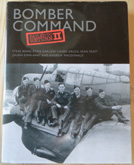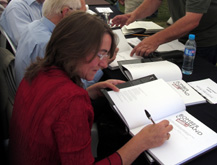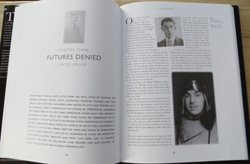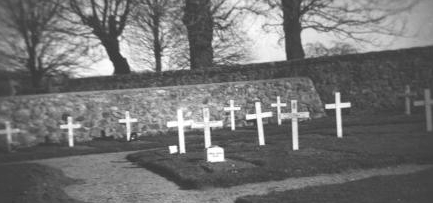Wellington R1646 - Glen Clunie
|
There are several pages relating to the tragic loss of this aircraft. Use the menu below to navigate around from page to page. To return to the Home Page of this website click 'Home'.
Bomber Command Failed to Return Volume II published by Fighting High Publications was launched in September 2012 at Duxford Air Show, and includes a chapter written by me about the loss of Wellington R1646 with the title 'Futures Denied'.
Wellington R1646 from 20 OTU The Last Flight. Lost then Found On Monday January 19th 1942, Wellington IC R1646 JM-D took off from 20 Operational Training Unit (20 OTU) at Lossiemouth on the North East Coast of Scotland on a training flight with a crew of eight men onboard. The aircraft failed to return and was listed as missing, presumed lost at sea. The winter of 1942 was one of the worst that the North East of Scotland had ever experienced with heavy falls of snow and bitterly cold temperatures. It was to be several weeks before the fate of the Wellington and her crew was discovered. About one month after the disappearance of the Wellington, Gamekeeper James Wright* was out in the hills checking the deer on the Invercauld Estate**,some 60 miles (approx 96 km) south of Lossiemouth as the crow flies. While scanning the snow covered landscape he saw something glinting on part of the hillside. Working in the hills and glens every day as he did, he was familiar with the terrain and how it looked in every type of light and weather. Something was different from usual, and he had noticed this. Using his telescope, carried by all gamekeepers, he focused in on the object and was sure that it looked like the tail section of an aircraft. *James Wright was one of three gamekeepers working in the glen at that time, the other two being his cousin, Jock Wright who lived at Callater Lodge beside Loch Callater and Archibald McHardy. **The Invercauld Estate has been owned for centuries by the Farquharson family and extends to over 200 Square miles of countryside. Later that day, James Wright went to the nearest village, Braemar, and reported what he had seen through his telescope to the local Policeman, Constable Gerrie. Constable Gerrie then telephoned his Head Quarters in Aberdeen to enquire if there were any aircraft listed as missing in his area and was informed that there were none. James Wright, however, was convinced that what he had seen was part of an aircraft. He was also a member of the local Home Guard, and so it was decided that the following day a small search party would go and further investigate what he had seen on the hillside. The population of Braemar in 1942 was depleted of young men. They had all gone off to fight in the war leaving behind only young boys, old men and those men who were in reserved occupations. Mid morning the following day, a search party set off from Braemar. They were four in number, Constable Gerrie, James Wright and two relatives of his, William Brown and his young 15 year old son, Andy Brown. William Brown was an employee of the local Council and was responsible for the roads in the area, he was also a member of the Home Guard. It was a cold and frosty day, the men took a lorry with a snow plough on the front as far as Glen Clunie Lodge. Beyond Glen Clunie Lodge the snow was too deep and the lorry was unable to take them any further so they left it there and continued the remaining 1-1.5 miles (2-3 km) on foot. Andy Brown remembers that the deep snow was frozen solid on the surface which made the walk a little easier as they were not sinking in too much as they went along. During the war years the road through the mountains between Braemar and Blairgowrie was not kept open once blocked with snow. From the Braemar side it was sometimes passable as far up as Glen Clunie Lodge (where the Baddoch Burn meets the Clunie Water), but often only as far up as Auchallater, a sheep farm situated where the Callater Burn meets the Clunie Water, some 1.5 miles (3 km) south of Braemar. It was normally blocked until some time in April. When the party of four reached the spot on the road below where Jimmy Wright had seen what he thought was the aircraft they stopped and looked up the hillside. They too could see something glinting in the sun but couldn't be sure that it wasn't maybe just frost on a rock. They decided to go on up to be sure. This part of the trip was extremely arduous. Being higher up, the snow was colder and more powdery than further down the glen thus they found themselves in waist deep snow, wading up the steep hillside . Finally they reached the crash site and it became obvious that what Jimmy Wright had seen glinting in the sun was the glass from the rear gun turret as all that was visible was this and the tail of the aircraft. The rest of the aircraft was well buried under the snow and it was obvious it had been there for some weeks and that there was no sign of life, it was impossible to even make out what type of aircraft lay beneath the snow. There was nothing for the search party to do at the scene so they returned to Braemar where Constable Gerrie once again telephoned his Head Quarters and this time was able to verify that the wreckage of an aircraft had been located on the hillside in Dubh-chorie, Glen Clunie. The RAF were duly informed about the discovery of the wreckage on February 22nd 1942 and a surveying unit was sent out to the scene of the crash to investigate. Weather conditions were extreme making it incredibly difficult to even access the wreckage. Steps and paths had to be cut out of the ice and snow covered hillside in order to allow access to the wreckage. Over the next two months, the bodies and remains of the eight men onboard were recovered and were buried in Dyce Old Churchyard near RAF Dyce (now a civilian airport), Aberdeen. On March 2nd 1942, the remains of Flight Sergeant H J Kelley RCAF, Sergeant J B Riley RAFVR, Sergeant B C Dickson RAAF, Sergeant R A Milliken RAAF, Sergeant M J Kilburn RAFVR and Sergeant W M Greenbank were buried in Dyce Old Churchyard and each grave marked with a wooden cross bearing their name.
The bodies of Flying Officer J W Thomson RNZAF and Sergeant R J Jackson RCAF were recovered from the scene of the crash on April 15th 1942 and were buried in Dyce Old Churchyard along side the rest of their crew, with a wooden cross to mark each grave, on April 17th 1942. By the end of April 1942, the main parts of the aircraft and any instruments considered as valuable or secret had been removed by 56 Maintenance Uniti (56 MU). The recovery had finally been completed. In November 1942, Sergeant Greenbank was reinterred in his home town cemetery and he now lies at rest in St Mary's Cemetery, Windermere, Westmoreland, England. In January 1943, Sergeant Kilburn was reinterred in his home town cemetery and he now lies at rest in Green Lane Cemetery, Farnham, Surrey, England. |
|||||||||
Thanks to Andy Brown and Keith Bryers for information about the loss of this aircraft and to Bob and Rae Fell for image of original graves at Dyce Old Churchyard. |
© Linzee Duncan 2002-2014



